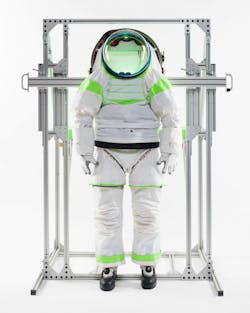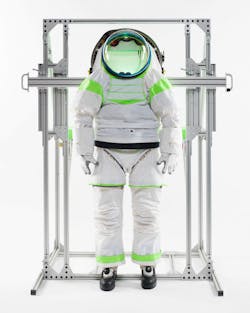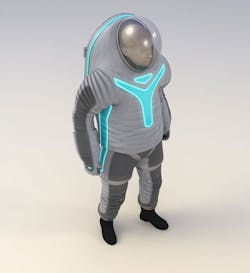NASA Develops Prototypes for Next-Generation Spacesuit
This file type includes high resolution graphics and schematics when applicable.
NASA astronauts currently don 240‑lb spacesuits designed 30 years ago when they have to go for spacewalks. But those heavy, clumsy suits will no longer fit the bill when NASA lands astronauts on Mars, a goal only 16 years off. The next generation of suits will have to serve double duty: protecting astronauts both as they float around in the zero-g and vacuum of space and as they walk through rough terrain on a planet with a low-pressure atmosphere and reduced gravity.
NASA engineers began developing the new spacesuit called the Z-1 a few years ago. Unlike the current suit, the Z-1 is meant to aid astronaut mobility. For example, bearings in the shoulder and hip joints will let astronauts dip down, walk, and bend more easily — all important tasks for exploring new terrain and collecting samples. And unlike the hard upper torso of the current space suit, the Z-1 uses a soft material that can handle the Z-1’s higher internal air pressure (so astronauts needn’t acclimate to lower pressures before suiting up). The higher internal pressure also called for redesigned gloves and boots that can be more easily tightened when the suit is fully pressurized.
Most importantly, engineers reduced the weight of the suit to 126 lb. One way they reduced weight was by adding a subsystem that removes CO2 from breathing air, ending the need for astronauts to carry canisters of CO2-absorbing lithium hydroxide.
The suit has an entry hatch on the upper back; astronauts climb into the suit, more akin to entering a small spacecraft than putting on a bulky suit of clothes. The entry hatch also serves as a suitport. The suit can attach to the outside of a spacecraft, rover, or space habitat. Astronauts inside the ship or rover can climb into the suit, seal it up, then detach and begin “walking” in space or across a planet. This eliminates the need for heavy and expensive airlocks. It also prevents dust or contaminants sticking to the outside of the spacesuit from getting inside the spacecraft or habitat, which was a problem with moon dust on Apollo missions.
In a nod toward styling (and Toy Story’s Buzz Lightyear), NASA added neon green striping to the suit. By using various colors for different astronauts, these bright highlights will allow astronauts to identify one another when suited up.
NASA came up with three different thematic cover layers for the follow-on prototype, the Z-2. The cover layer will protect the suit against snags and abrasion during a lengthy test period. The agency let people vote online for their favorite themes, including Biomimicry, Trends in Society, and — the winner, with almost 150,000 votes — Technology. The Technology Z-2 includes electroluminescent wire and patches across the upper and lower torso for identification and safety, exposed rotating bearings, collapsing pleats for mobility and highlighted movement, and abrasion-resistant panels on the lower torso. (For a look at the other themed suits, click here.)
Although neither the new suit nor cover layer will ever be used in space, the cover layer will be incorporated into the next suit, the Z-3. In space, the cover won’t be preventing snags and abrasions. It will protect astronauts against radiation, extreme temperatures, and micrometeorite strikes. That means it must be made of high-performance materials and include design details not necessary at this stage of development
The Z-2 also includes a composite hard upper torso rather than a soft one. It provides the durability and strength needed for space walks. The shoulder and hip joints of the Z-1 were redesigned after extensive evaluations. The suit is now made of materials that will withstand a full vacuum. And the boots are now closer to what will be needed for space and planetary explorations.
The Z-2 prototype should be completed by this November and then will begin two years of testing.
This file type includes high resolution graphics and schematics when applicable.



